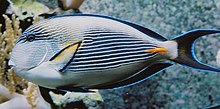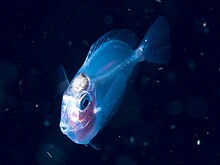| Surgeonfish Temporal range: Eocene–Recent PreꞒ Ꞓ O S D C P T J K Pg N | |
|---|---|

| |
| Sohal surgeonfish, Acanthurus sohal. The orange mark on the tail peduncle shows where the spine is folded in. | |
| Scientific classification | |
| Domain: | Eukaryota |
| Kingdom: | Animalia |
| Phylum: | Chordata |
| Class: | Actinopterygii |
| Order: | Acanthuriformes |
| Suborder: | Acanthuroidei |
| Family: | Acanthuridae Bonaparte, 1835 |
| Genera | |
|
see text | |

Acanthuridae are a family of ray-finned fish which includes surgeonfishes, tangs, and unicornfishes. The family includes about 86 extant species of marine fish living in tropical seas, usually around coral reefs. Many of the species are brightly colored and popular in aquaria.
Etymology and taxonomic history
The name of the family is derived from the Greek words akantha and oura, which loosely translate to "thorn" and "tail", respectively. This refers to the distinguishing characteristic of the family, the "scalpel" found on the caudal peduncle. In the early 1900s, the family was called Hepatidae.
Subfamilies and genera

Acanthuridae contains the following extant subfamilies and genera:
- Subfamily Nasinae Fowler & Bean, 1929
- Subfamily Acanthurinae Bonaparte, 1835
- Tribe Acanthurini Bonaparte, 1839
- Genus Acanthurus Forsskål 1775
- Genus Ctenochaetus Gill, 1884
- Tribe Prionurini J. L. B. Smith, 1966
- Genus Prionurus Lacépède, 1804
- Tribe Zebrasomini Winterbottom, 1993
- Genus Paracanthurus Bleeker, 1863
- Genus Zebrasoma Swainson, 1839
- Tribe Acanthurini Bonaparte, 1839
Evolution and fossil record
There are several extinct genera known from fossils dating from the Eocene to Miocene:
Eocene genera
Oligocene genera
Miocene genera
Morphology
The distinctive characteristic of the family is that they have scalpel-like modified scales, one or more on either side of the peduncle of the tail. The spines are dangerously sharp and may seriously injure anyone who carelessly handles such a fish. The dorsal, anal, and caudal fins are large, extending for most of the length of the body. The mouths are small and have a single row of teeth adapted to grazing on algae.
Surgeonfishes sometimes feed as solitary individuals, but they often travel and feed in schools. Feeding in schools may be a mechanism for overwhelming the highly aggressive defense responses of small territorial damselfishes that vigorously guard small patches of algae on coral reefs. Most species are fairly small, with a maximum length of 15–40 cm (6–15.5 in), but some in the genus Acanthurus, some in the genus Prionurus, and most species in the genus Naso may grow larger; the whitemargin unicornfish (Naso annulatus) is the largest species in the family, reaching a length of up to 1 m (3 ft 3 in). These fishes may grow quickly in aquaria, so average growth size and suitability should be checked before adding them to any marine aquarium.

A larval acanthurid, known as an acronurus, looks strikingly different from the juvenile and adult forms of the same individual. It is mostly transparent and tends to have a pelagic lifestyle, living in open water for an extended period of time before settling on the ocean bottom near the shore, where it develops into the juvenile and ultimately the adult form.
Symbiotic bacteria
Acanthurids are the only known hosts of the bacteria of the genus Epulopiscium bacteria. These bacteria affect the digestion of surgeonfishes enabling them to digest the algae in their diet.
In the aquarium
| This section does not cite any sources. Please help improve this section by adding citations to reliable sources. Unsourced material may be challenged and removed. (June 2009) (Learn how and when to remove this message) |
Tangs are very sensitive to disease in the home aquarium. However, if the tang is fed enough algae and the aquarium is properly maintained disease should not be a problem. It is usually necessary to quarantine the animals for a period before introducing them to the aquarium.
Adults range from 15 to 40 centimetres (5.9 to 15.7 in) in length and most grow quickly even in aquaria. When considering a tang for an aquarium it is important to consider the size to which these fish can grow. Larger species such as the popular Pacific blue tang surgeonfish (of Finding Nemo fame), Naso or lipstick tang, lined surgeonfish, Sohal surgeonfish and Atlantic blue tang surgeonfish can grow to 40 cm (16 in) and require swimming room and hiding places.
Many also suggest adding aggressive tangs to the aquarium last as they are territorial and may fight and possibly kill other fish.
Tangs primarily graze on macroalgae from genera such as Caulerpa and Gracilaria, although they have been observed in an aquarium setting to eat meat-based fish foods. A popular technique for aquarists, is to grow macroalgae in a sump or refugium. This technique not only is economically beneficial, but serves to promote enhanced water quality through nitrate absorption. The growth of the algae can then be controlled by feeding it to the tang.
Gallery
- Selected species
-
 Achilles tang, Acanthurus achilles
Achilles tang, Acanthurus achilles
-
 Eyestripe surgeonfish, Acanthurus dussumieri
Eyestripe surgeonfish, Acanthurus dussumieri
-
Powderblue surgeonfish, Acanthurus leucosternon
-
 Doubleband surgeonfish, Acanthurus tennenti
Doubleband surgeonfish, Acanthurus tennenti
-
 Kole tang, Ctenochaetus strigosus
Kole tang, Ctenochaetus strigosus
-
 Bignose unicornfish, Naso vlamingii
Bignose unicornfish, Naso vlamingii
-
 Bluespine unicornfish, Naso unicornis
Bluespine unicornfish, Naso unicornis
-
Red Sea sailfin tang, Zebrasoma desjardinii
-
 Orangespot surgeonfish, Acanthurus olivaceus
Orangespot surgeonfish, Acanthurus olivaceus
-
Regal tang, Paracanthurus hepatus in an aquarium
References
- ^ Richard van der Laan; William N. Eschmeyer & Ronald Fricke (2014). "Family-group names of recent fishes". Zootaxa. 3882 (2): 1–230. doi:10.11646/zootaxa.3882.1.1. PMID 25543675.
- ^ Froese, Rainer; Pauly, Daniel (eds.). "Family Acanthuridae". FishBase. February 2007 version.
- Seale, Alvin (1909). "New Species of Philippine Fishes". Philippine Journal of Science. 4 (6). Bureau of Science in Manila. doi:10.5962/bhl.title.54135.
- J. S. Nelson; T. C. Grande; M. V. H. Wilson (2016). Fishes of the World (5th ed.). Wiley. pp. 497–502. ISBN 978-1-118-34233-6. Archived from the original on 2019-04-08. Retrieved 2023-07-10.
- Samuel Hubbard Scudder (1884). "Nomenclator Zoologicus: An Alphabetical List of All Generic Names that Have Been Employed by Naturalists for Recent and Fossil Animals from the Earliest Times to the Close of the Year 1879". Bulletin of the United States National Museum (19).
- Sorenson, L., Santini, F., Carnevale, G. and Alfaro, M.E. (2013) "A multi-locus timetree of surgeonfishes (Acanthuridae, Percomorpha), with revised family taxonomy". Molecular phylogenetics and evolution, 68(1): 150–160. doi:10.1016/j.ympev.2013.03.014
- W. S. Alevizon (1976). "Mixed schooling and its possible significance in a tropical western Atlantic parrotfish and surgeonfish". Copeia. 1976 (4): 797–798. doi:10.2307/1443464. JSTOR 1443464.
- Jonna, R. Jamil. "Acanthuridae (Surgeonfishes, tangs, unicornfishes)". Animal Diversity Web. Retrieved 2024-04-20.
- Miyake, Sou; Ngugi, David Kamanda; Stingl, Ulrich (2015). "Diet strongly influences the gut microbiota of surgeonfishes". Molecular Ecology. 24 (3): 656–672. doi:10.1111/mec.13050. ISSN 1365-294X. PMID 25533191. S2CID 206181801.
- Fishelson, L. (1999-03-01). "Polymorphism in gigantobacterial symbionts in the guts of surgeonfish (Acanthuridae: Teleostei)". Marine Biology. 133 (2): 345–351. doi:10.1007/s002270050473. ISSN 1432-1793. S2CID 84816281.
- Pollak, Peggy E.; Montgomery, W. Linn (1994-08-01). "Giant bacterium (Epulopiscium fishelsoni ) influences digestive enzyme activity of an herbivorous surgeonfish (Acanthurus nigrofuscus)". Comparative Biochemistry and Physiology Part A: Physiology. 108 (4): 657–662. doi:10.1016/0300-9629(94)90352-2. ISSN 0300-9629.
External links
 Media related to Acanthuridae at Wikimedia Commons
Media related to Acanthuridae at Wikimedia Commons- R. Jamil Jonna. "Acanthuridae: surgeonfishes, tangs, unicornfishes". Animal Diversity Web. University of Michigan Museum of Zoology.
- Sepkoski, Jack (2002). "A compendium of fossil marine animal genera". Bulletins of American Paleontology. 364: 560. Archived from the original on 2011-07-23.